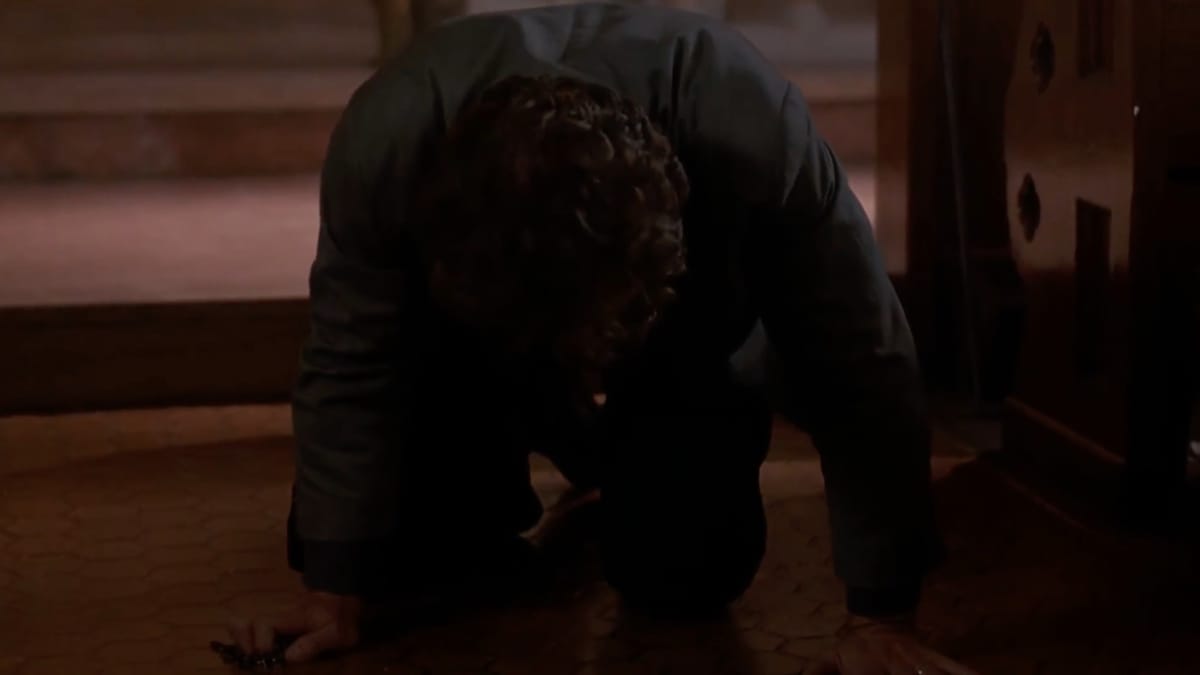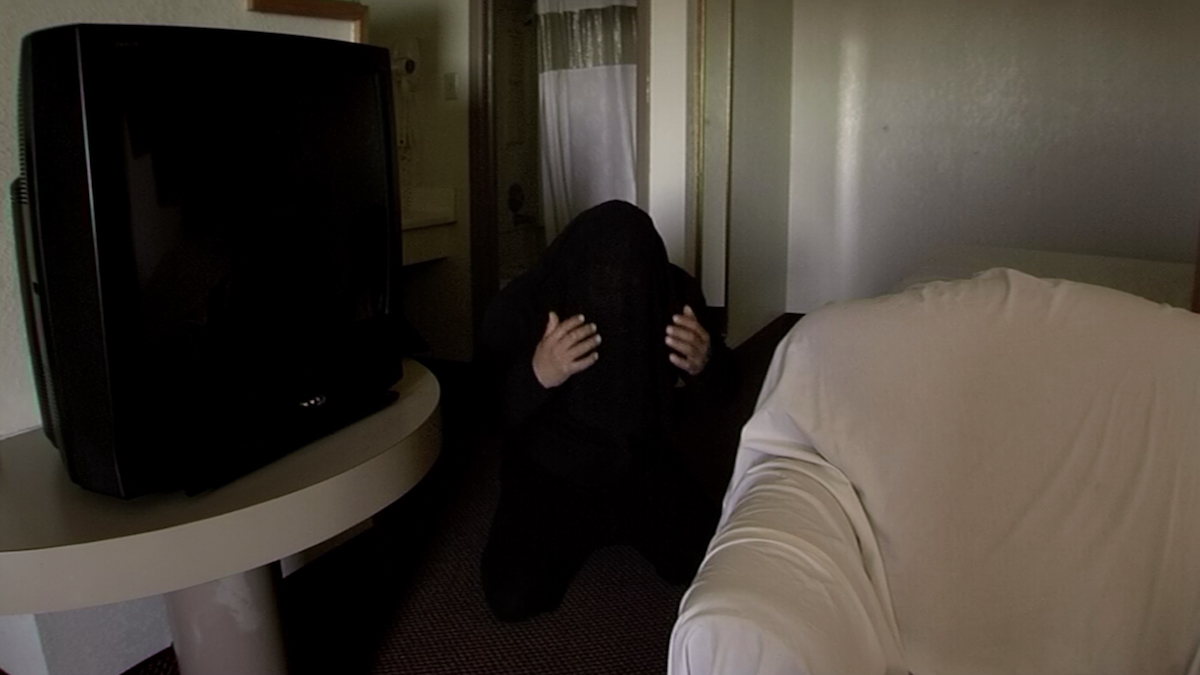'I've done so many bad things'

Abel Ferrara and Gianfranco Rosi offer attention and forgiveness in Bad Lieutenant and El Sicario, Room 164
Abel Ferrara’s 1992 film Bad Lieutenant is bluntly titled: its protagonist is just bad, there is no way around it. Even the term “antihero” feels too generous for this drugged up lieutenant who steals crime scene evidence and resells it to dealers in exchange for money, which he then bets on a consistently losing team. LT, played by Harvey Keitel, is caught in a spiral of badness which Ferrara exposes head on, holding nothing back. From the film’s rather comical opening scene, in which LT screams at his two teenage sons while driving them to school, to the more harrowing one where he visits a friend who helps him get high on heroin, the spectator is privy to every torturous moment of the protagonist’s day. The film embraces a fly-on-the-wall aesthetic, and it isn’t a coincidence that Ferrara went on to direct several documentaries. Some of his most recent work — Tommaso (2019) in particular, shot in his own home and starring his own wife — deftly blends fiction and documentary.
In his 2010 film El Sicario, Room 164, Italian-American filmmaker Gianfranco Rosi cannot present the frightful deeds that his protagonist has committed in such a direct way. Chronicling the man’s story some time after the fact, he gets his subject to explain in his own words how he became a killer working for the drug cartels and to detail the illegal activities and violence that the job involved. The masked and unnamed protagonist is never asked a question by Rosi, but instead leads this one-sided conversation himself. He owns the room, too, standing up to mime the torture methods he used on his victims or to reenact the crimes that he has committed in the very hotel room from which he is speaking in the film. A notepad and a pen given to him by the crew further encourage his self-expression, and his sketches help him illustrate the hierarchy he was operating under or the kidnapping tactics he would employ. He runs the show, and as in Ferrara’s film, all we can do is watch. Though the events he describes are not shown, Rosi and the Sicario give us all we need to picture them.
In both films, the reality of the protagonist’s vile behaviour is inescapable. The Sicario’s drawings and diagrams, however rudimentary and abstract, cannot help but stir our imagination, and although we may try to shield ourselves with the knowledge that Keitel is an actor and (probably) did not truly inject himself with drugs, Ferrara shows the needle going into his arm in close-up. Both films are confrontational and refuse to look away from the morbid reality of these lives. Yet this very insistence on showing their characters warts and all already suggests that Ferrara and Rosi’s interest in these men does not lie in their violence and misdeeds alone. Through their unflinching attention and unobtrusive approach, both directors demonstrate not so much a macabre curiosity for all things inhumane, as an extreme kind of patience and compassion. They deem LT and the Sicario to be worthy of our time and consideration.
Ferrara’s care for his protagonist shows in his refusal to over-dramatise even his darker moments. In the scene where LT stops two young women for supposedly driving with a broken light, then forces them to degrade themselves for him to watch and masturbate, Ferrara lets the strange exchange unfold in real time, positioning himself as a simple observer. Even as he shows the lieutenant getting angrier and his behaviour turning increasingly repulsive, the director does not prioritise LT’s experience. In turning his camera to the women’s reactions as well, Ferrara lets the audience see all facets of this moment, almost as in a documentary – and thus involves the spectator and their own judgement. Viewers are not told how to feel about the scene, but have to sit alone with their feelings.
Contrast this approach with that of Werner Herzog in his own Bad Lieutenant film, where a similar sequence shows Nicolas Cage’s lieutenant threatening a young couple in a car park, stealing their drugs, then having sex with the woman in front of her boyfriend. Dramatic low angles highlight Cage’s trademark expressionistic acting throughout, and the effect on the spectator is one of distanciation, fascination and even amusement. Cage’s lieutenant has gone off the deep end and is now on his own trip, cut off from the rest of the world. The corresponding scene in Ferrara’s film by contrast does not set the original LT apart from the people he is threatening. The women do not fade into the background and are not dwarfed into a corner of the frame by any fish-eye lenses. Ferrara subtly underlines the fact that despite their unequal power, all the characters in the scene remain part of the same world. There is no escape, which is precisely what makes for a painful and uncomfortable confrontation. LT is not framed as a ridiculous man to be shocked and/or mildly amused by, but as a troubled person who habitually creates incredibly distressing situations for himself and others. Ferrara’s calm and levelled approach, the frequent ellipses between LT’s bouts of drug use and the repetition of nearly identical scenes of corruption and misconduct give the sense of a life in which abuse has become routine, and show a man who simply cannot imagine any other way to live.
With hired killers having become such iconic figures in cinema, it can be difficult not to perceive Rosi’s decision to let a Sicario tell his tale as yet another morbidly voracious, thrill-seeking dive into the romanticised underworld of organised crime, and his film as a sordid platform for a person who does not deserve one. But like Ferrara, Rosi refuses to aggrandise – and therefore simplify or cheapen – his protagonist’s experience. The Sicario’s retelling of his deeds is vivid enough to maintain the viewer’s attention. But more than that, its rhythm also encourages listening. As though to counter the obscuring of facial expressions caused by the Sicario’s mask, Rosi uses long takes to preserve his character’s words and cadence and to keep viewers holding onto every word he says and every drawing he creates. Rosi is not simply interested in the Sicario’s story, but also in how the Sicario himself tells it, because like Ferrara with LT, he sees the man behind the vile acts. His camera draws the spectator’s attention to the Sicario himself and to the humanity lying underneath the mask and the words.
Working in two different film forms, both Ferrara and Rosi act as recipients for their characters’ stories and suffering: they listen patiently, letting the cycles of violence and degradation take their course without intervening to judge them. In that way, they predict and mirror the very compassion that their protagonists discover in the course of their own lives.
In Bad Lieutenant, LT finds a way out of his pain when he starts investigating a particularly challenging police case: a young nun who has been brutally raped by local boys in her church refuses to help LT identify the criminals. Instead, she wants to forgive them and sees the attack as part of God’s plan for these men to find their way. LT cannot understand her decision: forgiveness is unacceptable to him because he cannot imagine letting this horrific crime go unpunished. The nun’s reaction sends LT into a new kind of spiral: although he still follows his toxic routine of dangerous sex encounters, abuse and drugs, he becomes ever more haunted by the possibility of compassion and absolution, for those young men but also for himself. If their sexual assault can be forgiven and be received not with punishment, but with grace and clemency, could this mean that his own mistakes and failures could be pardoned, too? If God could accept and forgive him, just as Ferrara does, could LT begin to stop punishing himself for the awful things he has done?

Perhaps it isn’t a coincidence that Ferrara and Rosi both come to forgiveness from a religious angle – while Ferrara is of Italian descent, Rosi is himself Italian, and Catholicism remains firmly rooted in the culture of that country. It is also the dominant religion in Mexico, where the Sicario lived and “worked.” The latter recalls that, little by little, the cartel began to make him feel expendable and to threaten his family, yet he could not imagine a safe way out. It was when a friend offering him asylum took him to church one day that he began to find his freedom, within himself first. The Sicario explains that the sound of a rapturous choir brought him to his knees in a crying fit, as if he had been struck by the love of God or weighed down by all the pain he had caused others and himself. The immense love he felt around him during that gathering made him realise that he could get some of that love too; that even his cruellest deeds could be forgiven. In this place, he could let all his self-hatred and anger flow out of him and have it be received without judgement. He could also remember the happiness he had once known. “‘I want to belong to that family, I want to belong to Him,’” he recalls saying out loud. “Because He had given me what no one had given me: the satisfaction of knowing how good it is to live, to be free, to be with my brothers, my family, to enjoy life with the family I had lost.” As he talks about this turning point in his life, the Sicario in Rosi’s film becomes overwhelmed with emotion and falls to his knees, just as he did in that church. Rosi lets the camera roll. The director receives these intense emotions openly and offers his protagonist a safe haven not dissimilar to the one that the church once gave him.
Ferrara grants LT a similar outlet and refuge. Alone in the nun’s church, during what might be some kind of grief- or drug-induced hallucination, the lieutenant encounters Jesus himself and, like the Sicario, collapses and lets out all his rage. Kneeling, he first asks the apparition why he does not intervene to put a stop to all the suffering in the world and to his own unbearable pain. But the figure remains silent, and the lieutenant weeps and seethes even more (this may be Keitel’s most lived-in and best performance): to LT, Jesus’ silence looks like indifference. Soon, however, the man crawls to Jesus and kisses his feet, as if to thank him – the lieutenant appears to have understood that the son of God trusts him to find the solution alone. He has also realised that, though it may be a difficult path to walk on, forgiveness is the only way out of the anger he feels not only towards the world, but also towards himself. LT struggles with this sudden yet beneficial release of emotion and repressed anger, and his reaction is strikingly similar to the Sicario’s, as he describes it : “All I could feel was my body boiling, my blood boiling… Tears poured out of my eyes, an endless river of tears.”
By presenting their characters in these moments of surrender and liberation, Ferrara and Rosi prove that their own compassion for them was well placed — their protagonists are human after all. The source of their unthinkable behaviour is suddenly laid bare: rather than anything truly evil at their core, it was the very human emotions of fear and their suffering that led them to create more fear and suffering in the world and within themselves. As Ferrara and Rosi witness and accept the vulnerability, torment and regrets of their subjects, not so much despite the damage that they have caused around them as precisely because of it, their films offer a powerful perspective on crime and retribution. Contrary to vengeful instincts and structures of punishment, the crimes committed by LT and by the Sicario do not make them unworthy of our attention and mercy, but especially deserving of them instead. They need them more than anyone.
In fiction and in documentary, Ferrara and Rosi approach filmmaking as a healing instrument. Similar to the way Catholicism offers forgiveness to the wicked, their cinema here focuses on the unloved and the unloving to give them the space they believe they do not deserve. Rather than turn their attention to people on the fringes of society in an effort to further other them and perpetuate their exclusion, through this gesture, Ferrara and Rosi open up their characters’ futures and welcome them back into the fold of society. Their forgiveness is an act of hope, the hope that these people will find their way off the tracks that have kept them going in smaller and smaller circles, and onto a new, unknown, better path. No one can say what the two young men whom LT helps escape New York City at the end of Bad Lieutenant will become, but his act of faith does break the cycle of crime and punishment that all three of them were caught in. The Sicario from Rosi’s film, meanwhile, lives in hiding and is forever fearful of revenge (there is a $250,000 bounty on his head), but he has saved his family, himself and other potential victims from more suffering at his own hands. The story has been changed.




